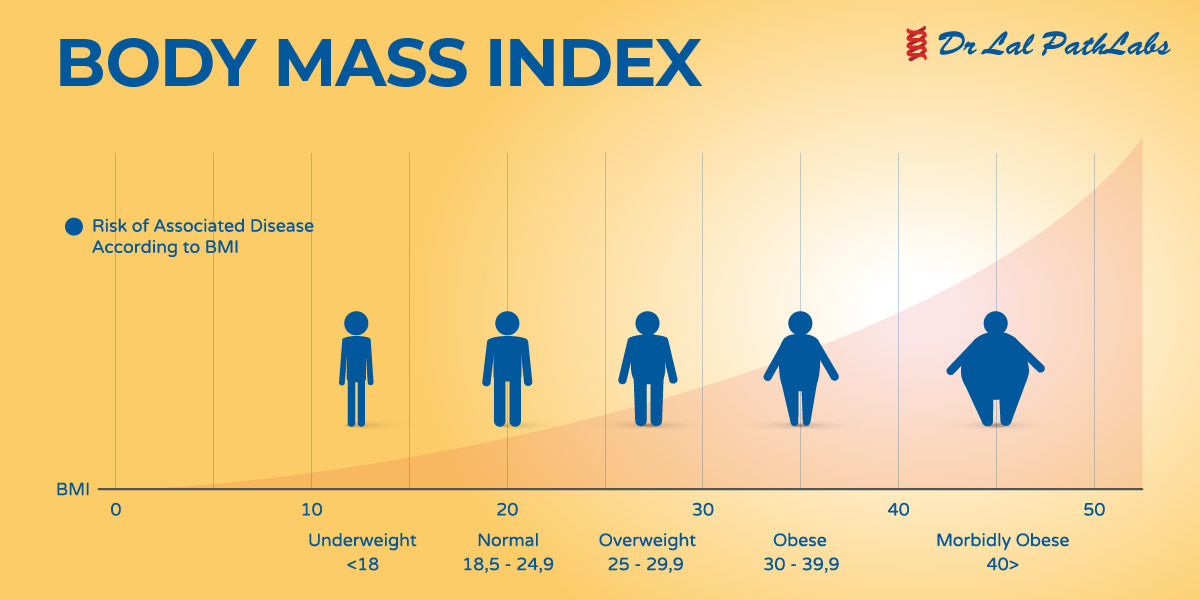Body Mass Index (BMI): What It Is & How To Calculate
What is the body mass index (BMI)?
The body mass index is a medical screening tool that uses your height and weight to estimate how much fat you have in your body.
How is BMI calculated?
A person’s BMI is calculated by dividing their weight in kilograms (kg) by their height in meters (m2). The WHO classifies BMI as follows:
- Underweight: If your BMI is 18.5 kg/m2, you are considered possibly malnourished
- Healthy weight: If your BMI is 18.5 to 24.9 kg/m2 you are within a healthy weight range.
- Overweight: If your BMI is 25 to 29.9 kg/m2 you are considered overweight.
- Obese: If your BMI is over 30 kg/m2, you are considered obese.
Examples of calculating BMI
For example, if a person weighs 64 kg and is 1.70 metres tall, their BMI will be:
Weight (kg) ÷ height (m)2 = 64 kg ÷ (1.70 m)2 = 22.14
Thus, BMI of this person is 22.
To measure your waist circumference, measure your abdomen at hip height with the tape.
Health Risks Associated with High BMI
If you have overweight, then you may be at risk of developing:
- High blood cholesterol
- Type 2 diabetes
- Heart disease
- Stroke
- High blood pressure
- Gallbladder disease
- Sleep apnea and snoring
- Osteoarthritis and joint disease
Health risks associated with low BMI
If you are underweight, then you may be at risk of developing:
- Comprised immune function
- Respiratory disease
- Digestive diseases
- Cancer
- Osteoporosis
Benefits of maintaining normal BMI
Keeping a healthy weight and body mass index has several benefits. It reduces the risk of having:
- Heart disease
- Stroke
- Diabetes
- Anemia
- Infertility risks
- Osteoporosis
Having a healthy body weight increases energy levels, optimizes the immune system, and relieves back and joint tension.
How is BMI interpreted for children and teens?
BMI for children is calculated with the same formula, but it is interpreted in a different way due to the changes in weight and height with age, as well as their relation to body fatness.
Tips to achieve a healthy BMI
You can maintain a healthy BMI by making a few changes to your lifestyle: Here are a few things you can do to maintain a healthy weight:
- Avoid food that is high in sugar, fats and calories.
- Eat a lot of fruit and vegetables.
- Exercise thrice a week.
- Limit alcohol consumption.
- Drink lots of water.
- Get enough sleep.
Limitations of BMI
There is a strong correlation between BMI and body fat, but two people with the same BMI may have different body fat levels.
BMI doesn’t measure the location or distribution of body fat due to the fact that excess fat accumulation in certain areas of the body is associated with a higher risk of health conditions.
Frequently Asked Questions
1. What is the body mass index?
Body mass index (BMI) is a tool that measures the amount of body fat by using your height and weight measurements.
2. What is the normal range of BMI?
The normal BMI range is 18.5 to 24.9 kg/m2.
3. How do I calculate my BMI?
A person’s BMI is calculated by dividing their weight in kilograms (kg) by their height in meters (m2). For example, Weight (kg) ÷ height (m)2 = 68 kg ÷ (1.65 m) 2 = 24.97
Disclaimer:
This blog is for informational purposes only and should not be construed as advice or as a substitute for consulting a physician. It is not a substitute for medical advice or treatment from a healthcare professional.














